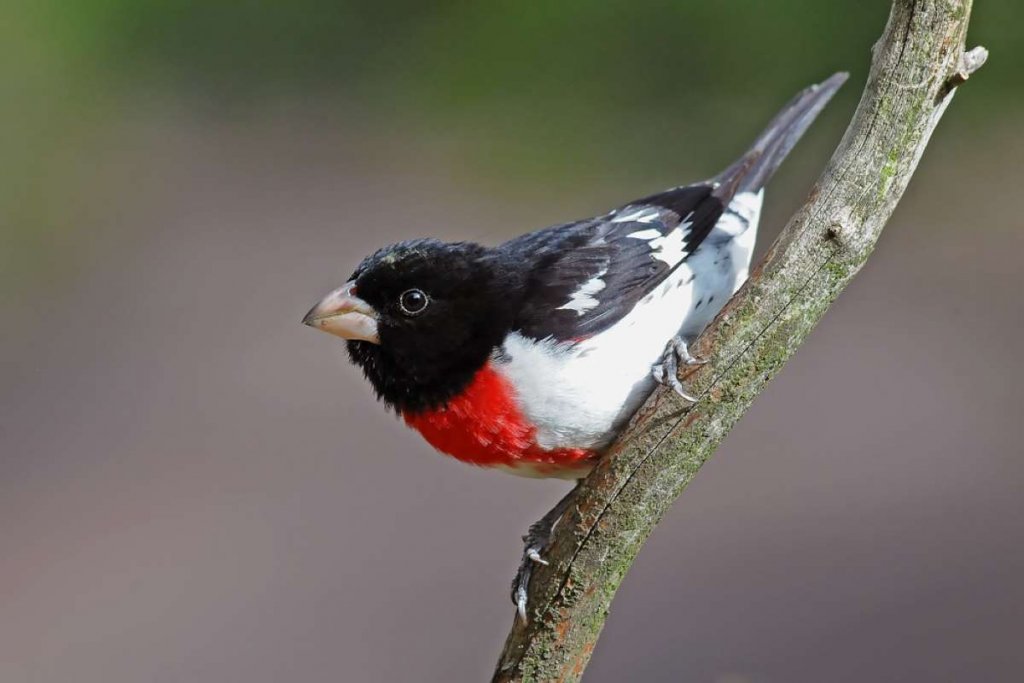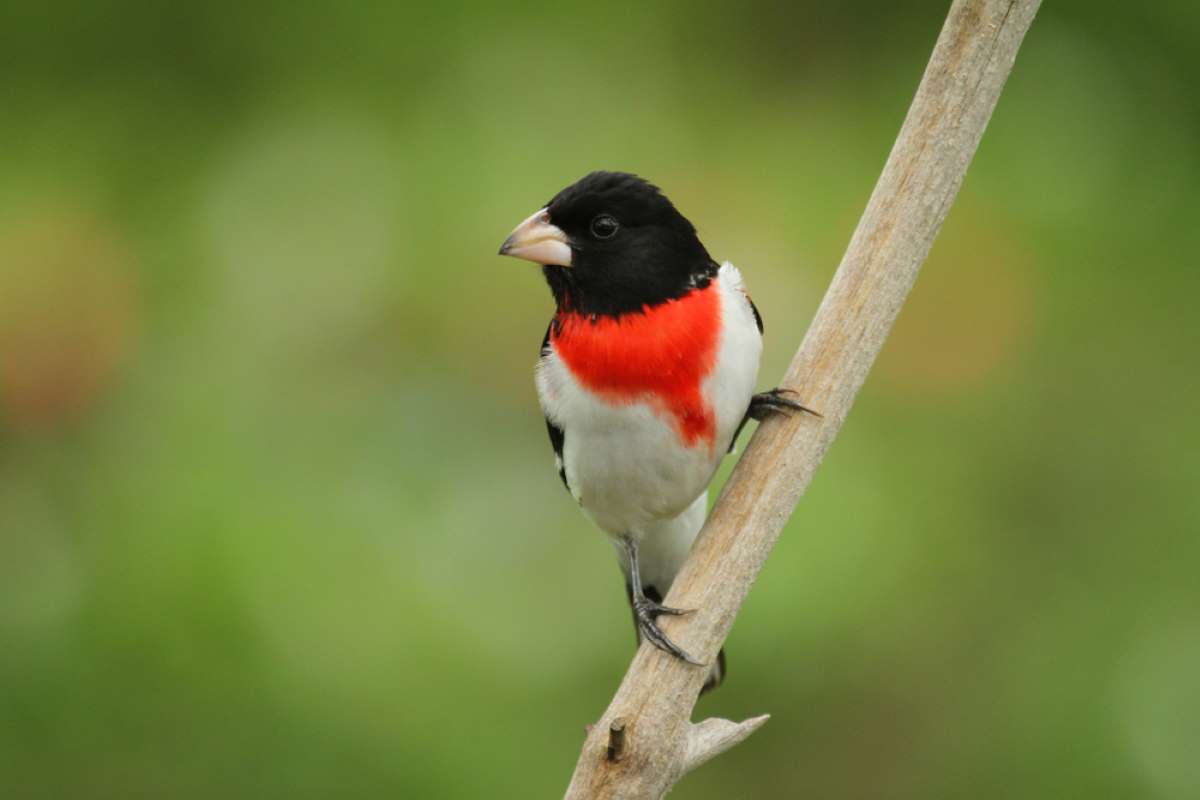Rose-breasted Grosbeaks are named for the rose-colored breast and throat of the male and the thick gray beak. These birds range from Central America to Canada. Their songs resemble the American Robin.
Rose-breasted Grosbeaks are medium-sized North American songbirds. They live in deciduous forests of North and Central America, feeding on berries, plants, and seeds.
Facts About The Rose-breasted Grosbeak (Pheucticus ludovicianus)
- The Rose-breasted Grosbeak is from the Cardinal (Cardinalidae) family in the order Passeriformes
- Named for the bright red breast and throat of the male
- They live a little over 7 years on average
- Common at backyard feeders in the Eastern US and Canada
- Rose-breasted Grosbeaks are larger than a House Finch but smaller than the American Robin
- Related to the Black-headed Grosbeak and the Blue Grosbeak and have been known to interbreed in parts of the Great Plains
- Juveniles can resemble finches—especially the Purple Finch—though they are not related
What Is The Difference Between A Male and Female Rose-breasted Grosbeak?
Adult Male Rose-breasted Grosbeaks can be identified by their bright red chevron feathers on their throat and breast. They have black heads, wings, tails, and backs. Males have two white patches and red linings on their wings. They have a white rump and underside.
Adult Female Rose-breasted Grosbeaks are dark grey or brown upper parts. They have dark wings and tails. They have a unique, white stripe that runs from the bird’s beak, above the eye, and onto the head, called a supercilium. Females’ underparts have black streaks with orange-colored tinges. Their wings are lined with yellow and have two patches of white on the top.
Juveniles have streaky brown underparts. All Rose-breasted Grosbeaks have thick pinkish-gray beaks, dark eyes, and dark feet. The name ‘Grosbeak’ comes from this large gray beak. Both males and females are medium-sized stocky songbirds measuring between 7.1 and 8.3 inches in length and weighing between 1.4 and 1.7 ounces. Their wingspan is between 11.4 and 13 inches.

How Rare Is A Rose-breasted Grosbeak?
The Rose-breasted Grosbeaks is a common North American bird. They are also found frequently in South America and Central America. They have been reported occasionally in western Europe and Iceland.
Rose-breasted Grosbeaks have declined in population since the mid-20th century. This is likely due to the loss of habitat in North America. Like other bird species, Rose-breasted Grosbeaks also face predators, contributing to their declining population. Experts estimate there are still about 4.7 million Rose-breasted Grosbeaks of breeding age.
Where Does The Rose-breasted Grosbeak Live?
The Rose-breasted Grosbeak lives in deciduous forests across the northeastern US and most of Canada. Rose-breasted Grosbeaks migrate long distances each season. These birds migrate north in late April or early May, often returning to the same places each year for breeding. Birders report Rose-breasted Grosbeaks commonly at backyard bird feeders.
During migration, they visit shrub thickets, dune ridges, wetlands, and urban areas. They also inhabit open woodlands, parks, gardens, and forest edges in colder months. Migrants leave northern breeding grounds in August and fly south. On their journey, they travel through the Rocky Mountains, Mexico, and Central America. Some fly as far south as Venezuela or Colombia. Some birds fly over the Gulf of Mexico in one night.
Breeding and Nesting
- Males and females choose a nest site together
- They are monogamous after mating
- Nesting materials include sticks, weeds, grasses, straw, hair, and leaves
- The nests are a loose open cup measuring 3.5-9 inches across
- Females lay 1-5 eggs at a time and can have 2 broods each season
- Egg incubation takes 11-14 days; males and females take turns sitting on the eggs
- Young remain in the nest for 9-12 days after hatching
- Common nest predators include Blue Jays and Grackles

What Is A Rose-breasted Grosbeak’s Diet?
Rose-breasted Grosbeaks eat a large variety of foods. They eat plants or seeds year-round. They especially love sunflower seeds. If you want to attract the Rose-breasted Grosbeak, hang sunflower seed feeders. They will feed from either tray or tube feeders. They sometimes even feed from hummingbird feeders because they like sweet sugar water.
During nesting season, they increase their food sources to include insects and berries. Their preferred diet includes blackberries, raspberries, milkweed, oats, wheat, and tree blossoms. Their large, tough beak is ideally suited for bigger insects, including beetles, grubs, gypsy moths, and caterpillars. They can eat tougher foods than other birds because of their heavy beak.
What Does The Rose-breasted Grosbeak Sound Like?
The Rose-breasted Grosbeak sounds similar to the America Robin or the Tanager. Their song is subdued and mellow and consists of a long string of whistles strung together. Each song has between 9 and 11 syllables. Their call is a sharp ‘chink’ or ‘pick’ similar to a Woodpecker. Both males and females produce this call.
Males begin singing in late winter as they prepare for spring and summer. Males sing to attract females for mating and to establish territories for breeding. When males sing songs consecutively, they often begin songs with the same syllable. Later syllables often vary and songs often alternate between short and long syllables.

